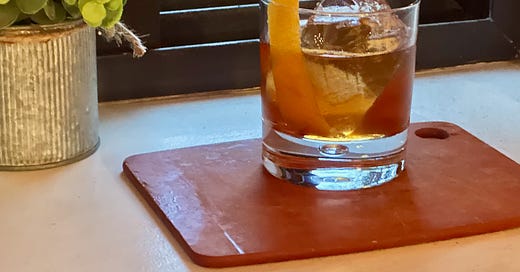This Bourbon and Rum Old Fashioned Is Bananas
Literally. It's got rum, bourbon, and banana liqueur. It's really good!
Years ago, Netflix used to group movies together by obscure subgenre. People made fun of this, and it was admittedly sort of ridiculous. But then you’d look and see that there were, in fact, quite a few “steamy independent movies based on books” or “visually striking gory crime movies.”1
Not enough to categorize as full-fledged genres unto themselves—these movies still fit into “romance” or “crime”—but enough to mark them as discrete subgenres and categories. Typically movies in the same subgenre would have an identifiable playbook. There were repeat elements, plot devices, overlapping tones, and sometimes even shared creative talent. But not every element appeared in every entry, and some would have wholly novel elements or tones.
The same goes for cocktails. Sure, there are big-picture drink categories: the Old Fashioned, the Manhattan/Martini, the Daiquiri, the Margarita/Sidecar, the flip, and so forth. Most drinks fit into one of these big picture templates. But then there are the subgenres. And if you peruse enough cocktail recipes, and make enough drinks, you’ll eventually start to recognize them.
For example, the fruited Old Fashioned, exemplified by the Death & Co. pineapple Old Fashioned I wrote up a few weeks ago. The Fancy Free, an old-school Old Fashioned sweetened by maraschino liqueur, probably fits into this category, in something like the way that Double Indemnity, Body Double, and Brick are all noirs of a sort. The Pecan Pie Old Fashioned we made for Thanksgiving a few years ago isn’t fruited—but structurally it’s very similar to the pineapple Old Fashioned, though it uses vanilla liqueur instead of pineapple. Last week’s rye/peach/honey Old Fashioned also fits the bill, although it’s built a little bit differently, relying on fruity bitters rather than a fruit liqueur. Most of these drinks also share something in common with liqueur-sweetened Old Fashioneds like the Monte Carlo and the Rusty Nail, although both of those drinks take the format in a more herbal direction.
As with Netflix, it might seem a little bit silly to try to categorize cocktails this way. Fundamentally, most drinks fit into one of a handful of major categories. Why try to slot them into ever-more-niche subcategories?
The answer is that if you’re interested in the art and craft of mixed drinks, then categorization is a key tool for understanding how and why drinks work. Those subgenres show you repeat patterns in drink construction.
And identifying patterns is inherently useful for understanding…well, almost anything. Statistics is just pattern identification. Today’s new-fangled AI tools are driven by super complicated, super advanced pattern recognition systems. Lawyering involves tracing and understanding patterns in case law. (Not surprisingly, a cocktail enthusiast lawyer gave us our first serious attempt to categorize and classify most cocktails.) Sci-fi author William Gibson, prophet of the internet, literally wrote a novel titled Pattern Recognition. Pattern matching, pattern history, pattern identification — that’s where good ideas come from!
So this week, we’re going to look at a fairly obscure cocktail that draws together a lot of the ideas we’ve looked at over the last month or so — plus one additional technique from the archives.
It’s a fruited Old Fashioned sweetened by a distinctive liqueur. But it’s also a split base Old Fashioned, like we’ve looked at in previous years, built on a combination of bourbon and aggressive, funky, high-proof Jamaican rum. It’s not a drink you’ll find in most cocktail books or on many cocktail menus. But it’s full-bodied, intense, conceptually interesting and structurally rigorous.
There’s no Cynar this week. But there is banana liqueur. And ridiculous rum. And bourbon. It’s a good drink!
Cocktail Kaiju?
When it comes down to it, a lot of cocktail design is about fine-tuning a drink’s sweetness. That’s especially true of Old Fashioneds, which rely on a fairly delicate balance of sweet, bitter, and strong.
When I wrote up the pineapple Old Fashioned, I argued that it could be used as a starting template for fruited Old Fashioneds — but that you might have to adjust the sweetener somewhat. That’s what this drink does.



